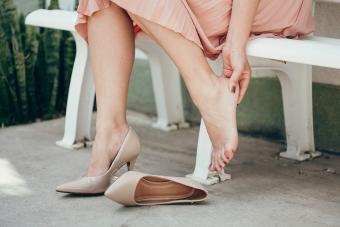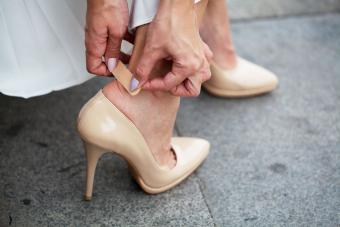
Blisters-sometimes called water blisters-are fairly common. These fluid-filled sacs often occur when there is friction or other damage to the skin. They happen to almost everyone at one time or another, but fortunately, these tender spots are simple to treat and usually take little time to heal.
What Are Water Blisters?
The medical term for a blister depends on its size. Small blisters are referred to as "vesicles" by medical professionals. Those that are larger than a half-inch are called "bulla" or "bullae" (if there is more than one).
Different types of blisters can occur on the skin. For instance, blood blisters are easy to identify because they are filled with dark red fluid that resembles blood. On the other hand, water blisters are filled with clear serum and look like a bulbous pocket of water. Single blisters or clusters may appear wherever the body needs healing.
Where Do Blisters Occur?
Your skin has three layers: the epidermis or top layer, the dermis or middle layer, and the hypodermis, a deeper subcutaneous layer that is made up of fat and connective tissue. According to medical sources, these layers work together to protect the body from pathogens, UV light, chemicals, and mechanical injury.
When friction or damage occurs to the outer layer of the skin, a fluid-filled sac forms under the epidermis. The National Library of Medicine reports that the most common areas where blisters form are the hands and feet.
What Is the Water in a Blister?
The fluid inside a blister looks like water, but it is actually a serum. The serum drains into the blister from other tissues near the injury.

Water blister fluid contains proteins and other substances that help promote healing. One research study found that blisters can also contain sodium, potassium, and chloride.
Several other research studies have examined the fluid in different types of blisters (such as those on burn victims) and have found that the fluid helps to promote healing by creating a good environment for fibroblasts, which are cells that produce collagen and other fibers. Acting as a protective shield, the serum also pads the wound and prevents further harm.
Causes of Blisters
There are several possible reasons why blisters form. Health experts at Harvard Medical School list the most common causes:
- Allergies
- Certain skin diseases
- Contact dermatitis (poison ivy, chemicals, and other irritants)
- Electrical burns
- Exposure to heat or extreme cold
- Friction or irritation
- Some medications (such as NegGram and Lasix)
- Sunburn
- Viral infections, such as shingles, chickenpox, or herpes
While some serious medical conditions can cause blisters, the most common cause is simple irritation from poorly fitting shoes, gloves, or clothing. People often get blisters after running in new shoes, hiking, or wearing gloves that rub against the skin while doing repetitive lifting or other work activities.
Blister Treatment
Taking proper care of a blister is essential to avoid pain or discomfort during the healing process. For the most part, water blisters do not require treatment. The Cleveland Clinic advises that most blisters heal in a matter of days.

However, you can do a few things to speed up the healing process. The American Academy of Dermatology (AAD) suggests that you leave the blister alone in most cases. They also suggest that you avoid doing whatever caused the blister in the first place.
In addition, the medical organization recommends the following steps:
- Loosely cover the blister with a bandaid
- Use a donut-shaped pad to protect the fluid sac
- Keep the area clean and covered
Should You Drain a Blister?
While it may be tempting to pop a blister, doing so puts you at greater risk for infection and allows the serum to escape. Since the serum contains substances that can promote healing, draining it isn't helpful.
However, the AAD acknowledges that some blisters need to be popped. For example, if it is large and very painful, you might choose to drain it. One way to manage this type of blister is to go to your healthcare provider. They will use sterile methods to minimize the risk of infection.
If you choose to drain your blister at home, the AAD suggests that you:
- Sterilize a small needle using rubbing alcohol.
- Carefully pierce one edge of the blister.
- Allow some of the fluid to drain.
- Wash the area with soap and water.
- Apply petroleum jelly.
The AAD recommends that you not remove the top layer of skin covering the fluid (the "roof" of the blister). Doing so exposes the irritated raw skin, which can impair healing.
During the healing process, keep an eye on the blister to look for any signs of an infection. If you see redness, pus, or experience increased pain or swelling, reach out to your healthcare provider.
Blister Prevention
Since most blisters are caused by friction from shoes, clothing, or gloves, there are simple steps you can take to reduce the incidence of blisters.
Wear Shoes that Fit Properly
The number one cause of a blister is ill-fitting shoes. Shoes that are too large or too small can cause friction. A rule of thumb when shopping is to have half-inch an inch of space between the toe and end of the shoe. It should not slip on easily or move around when you walk. Additionally, examine the shoes for seams that may rub against the skin.
Invest in Quality Socks
Be sure to wear proper socks as well. Avoid wearing old, thin socks, as they will not provide enough protection. In general, avoid cotton. Instead, look for moisture-wicking socks that move sweat away from the skin during sports and other activities.
Find Sport-Specific Clothing and Gloves
Some sports activities put you at risk for blisters on your hands or on your body. For instance, if you notice irritation between your thumb and forefinger (or anywhere on your hand) after a long bike ride or after weight lifting, consider getting a pair of gloves. There are certain types of sport-specific gloves that allow your fingers to remain bare but protect the palm and base of the thumb to prevent blisters.
Similarly, look for clothing that minimizes friction on the body to prevent blisters. Long-distance runners, for example, often choose lightweight, moisture-wicking tops and shorts to reduce rubbing during long workouts.
Avoid Sunburns
When the body heals from a painful sunburn, it often produces blisters. The key to protecting your skin is to avoid a sunburn altogether. Protect your skin by applying sunscreen with an SPF of 30 or higher. Then reapply throughout the day and wear sun-safe clothing.
Create a Barrier
If proper shoes, clothing, and gloves aren't enough to reduce rubbing in certain areas, create a barrier with moleskin or petroleum jelly to protect your skin. There are also some bandages created specifically for certain areas of the feet (such as the heels) that are prone to blisters.
Use Common Sense
The most important step you can take to protect yourself from blisters is to stop any activity when you notice irritation or damage to the skin. Many times, we feel friction in our feet but continue to walk in shoes that hurt. While it might seem reasonable in the short term, getting a blister can derail activities for up to a week.
While water blisters are usually not a serious medical problem, they can be uncomfortable and problematic if they get infected. Use a dose of common sense and good skin hygiene to keep your body and your skin healthy and safe.







